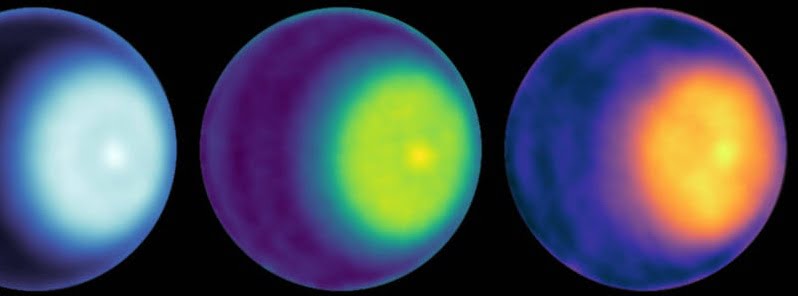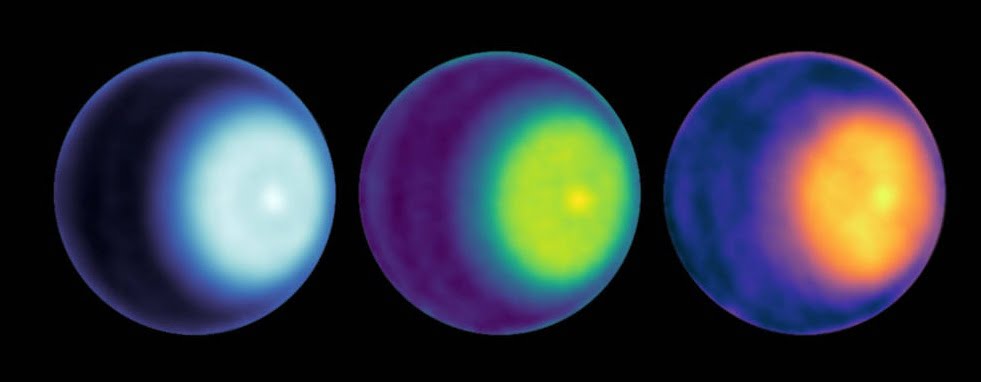First observation of a polar cyclone on Uranus

NASA scientists have confirmed the presence of a polar cyclone at the north pole of Uranus. The data, gathered between 2015 and 2022 using the Very Large Array in New Mexico, revealed warmer and drier air circulating below the planet’s clouds, a key indicator of cyclonic activity. The findings were published in Geophysical Research Letters.
The investigation, carried out at the Very Large Array in New Mexico, utilized huge radio antenna dishes to peer beneath Uranus’ cloud layers. According to their findings, the air circulating at the planet’s north pole is noticeably warmer and drier than surrounding areas – distinct signatures of a robust cyclone. This key data was collected over an extended period, from 2015 to 2022, penetrating deeper into Uranus’ atmosphere than any previous exploration.
Confirming earlier speculations, these observations add weight to the notion that significant atmospheres on planets in our solar system, whether made predominantly of rock or gas, exhibit signs of a swirling vortex at the poles. Prior imaging by NASA’s Voyager 2 of Uranus’ south pole showed similar characteristics, such as wind patterns spiraling faster at the pole’s center than over the rest of the pole. Infrared measurements taken during the Voyager mission, however, noted no temperature variations, a discrepancy rectified by the new findings.
The study, published in Geophysical Research Letters, emphasizes the dynamic complexity of Uranus.
“It’s a much more dynamic world than you might think,” stated Alex Akins, the lead author of the study from NASA’s Jet Propulsion Laboratory in Southern California. “It isn’t just a plain blue ball of gas. There’s a lot happening under the hood.”

Further, the recent shift in Uranus’ orbit has allowed scientists a more unobstructed view of the planet’s polar atmosphere since around 2015. Uranus’ 84-year-long orbit means that for decades, the planet’s poles were not directly observable from Earth.
The cyclone discovered on Uranus, compact with warm and dry air at its core, bears a striking resemblance to those seen on Saturn through NASA’s Cassini mission. Every planet in our solar system with substantial atmospheres, excluding Mercury, has now been identified to exhibit cyclones or anti-cyclones at their poles. These space cyclones differ from their terrestrial counterparts in that they do not form over water and remain stationary at the poles rather than drifting.
The implications of this groundbreaking discovery are potentially far-reaching, with researchers eager to monitor the evolution of the newly discovered cyclone on Uranus in the coming years. Akin posed some intriguing questions: “Does the warm core we observed represent the same high-speed circulation seen by Voyager? Or are there stacked cyclones in Uranus’ atmosphere? The fact that we’re still finding out such simple things about how Uranus’ atmosphere works really gets me excited to find out more about this mysterious planet.”
Research:
1 Evidence of a Polar Cyclone on Uranus From VLA Observations – Alex Akins et al. – Geophysical Research Letter – May 23, 2023 – https://doi.org/10.1029/2023GL102872 – OPEN ACCESS
2 NASA Scientists Make First Observation of a Polar Cyclone on Uranus – NASA/JPL – May 23, 2023
Featured image credit: NASA/JPL

Commenting rules and guidelines
We value the thoughts and opinions of our readers and welcome healthy discussions on our website. In order to maintain a respectful and positive community, we ask that all commenters follow these rules.